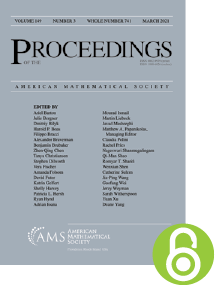Additivity of measure implies dominating reals
HTML articles powered by AMS MathViewer
- by Arnold W. Miller PDF
- Proc. Amer. Math. Soc. 91 (1984), 111-117 Request permission
Abstract:
We show that additivity of measure $A\left ( m \right )$, the union of less than continuum many measure zero sets has measure zero) implies that every family $F \subseteq {\omega ^\omega }$ of cardinality less than continuum is eventually dominated (this is the property $D$). This yields as a corollary from known results that $A\left ( m \right ) + B\left ( c \right ) \to A\left ( c \right )$. $A\left ( c \right )$ is the property that the union of less than continuum many first category sets has first category and $B\left ( c \right )$ is the property that the real line is not the union of less than continuum many first category sets. Also, a new property of measure and category is introduced, the covering property, $C\left ( m \right )$, which says that for any family of measure zero (first category) sets of cardinality less than the continuum there is some measure zero (first category) set not covered by any member of the family. By dualizing the proof that $A\left ( m \right ) \to D$ we show that $wD \to C\left ( m \right )$. The weak dominating property, $wD$, says that no small family contained in ${\omega ^\omega }$ dominates every element of ${\omega ^\omega }$.References
- Kenneth Kunen and Jerry E. Vaughan (eds.), Handbook of set-theoretic topology, North-Holland Publishing Co., Amsterdam, 1984. MR 776619
- Arnold W. Miller, Some properties of measure and category, Trans. Amer. Math. Soc. 266 (1981), no. 1, 93–114. MR 613787, DOI 10.1090/S0002-9947-1981-0613787-2
- Arnold W. Miller, A characterization of the least cardinal for which the Baire category theorem fails, Proc. Amer. Math. Soc. 86 (1982), no. 3, 498–502. MR 671224, DOI 10.1090/S0002-9939-1982-0671224-2 F. Rothberger, Eine Äquivalenz zwischen der Kontinuumhypothese und der Existenz der Lusinschen und Sierpińskischen Mengen, Fund. Math. 30 (1938), 215-217.
Additional Information
- © Copyright 1984 American Mathematical Society
- Journal: Proc. Amer. Math. Soc. 91 (1984), 111-117
- MSC: Primary 03E35; Secondary 03E40
- DOI: https://doi.org/10.1090/S0002-9939-1984-0735576-9
- MathSciNet review: 735576


